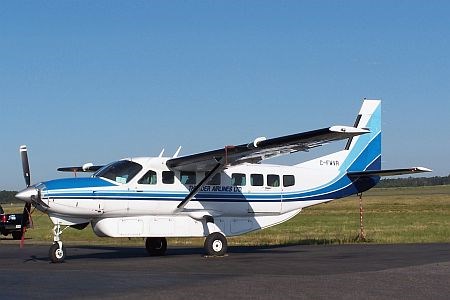There are many way to gauge the economic health of the city, Timmins airport manager Harley Nikkel says, but what he uses is one simple glance
"I can tell how things are going on a daily basis, without having to spend much time looking at facts and figures, by looking out the window at my public parking lot, and that's my economic barometer," says Nikkel.
"After 35 years of doing this, you can get a sense of flight activity and such just by looking out there, and it's full, even after expanding it to 200 spaces a couple years ago."
At a time when many Canadian airports are struggling to maintain ridership levels, passenger traffic statistics have climbed strongly over the last three years at Timmins' Victor M. Power Airport.
While the national average increase in airport activity has climbed between two and three per cent, Timmins numbers have increased 40 per cent. Statistics are not yet available for the past six months.
Flight activity has also seen some recent strength. In 2006, there were roughly 27,000 takeoffs and landings, a number now approaching 32,000.
Despite this growth, the numbers indicate that although there are more flights, there are also more passengers on each flight, translating to much fewer empty seats.
Much of this activity can be attributed to the continuing good fortunes seen in and around the city in recent years, says Nikkel, thanks in no small part to mineral exploration projects and the construction of the De Beers Victor Diamond Mine.
Even though the Victor Mine was complete and operational as of 2008, contributing to a slight softening of the flight numbers, the company still conducts three scheduled charters every week through its ongoing contract with Air Creebec.
Other charter business for moving people, goods, and freight at the facility is handled through Air Bravo, Wasaya Airways and Thunder Airlines.
Though this aspect of the business has been steadily growing, the major traffic component for Timmins continues to be commercial flight activity, handled through Air Canada Jazz, Air Creebec and Bearskin Airlines.
General aviation activity has become much more subdued through the first half of 2009, though a mild increase in private owner/operator interest has led to hangar development, with two going up in the last year.
In response to industry requests, Nikkel is pursuing additional land development for aviation and non-aviation use at the airport.
Potential uses for this development range from hangar development lots to light industrial warehousing., and will likely make use of the "attractive" availability of a kilometre's worth of highway access lands.
Other major projects expected to be undertaken "in the not-too-distant future" include a taxiway rehabilitation program. Officials are also looking at a capital fleet replacement program, which involves purchasing new airport maintenance equipment such as snow removal trucks and plows as well as runway sweepers.
Elevated traffic numbers and ongoing investments at the airport have helped to draw interest from various aviation carriers from around the province, who have begun "very preliminary" discussions with local officials.
"We're here to foster aviation, to grow it," says Nikkel. "And like I say, what's good for aviation is good for the airport, and what's good for the airport is good for the city."




